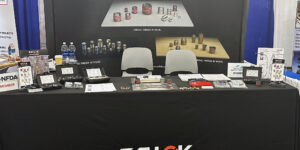SEE THE LIGHT: THE EMERGING ROLE OF ALUMINUM IN SOLAR POWER
Another Sustainable Alternative Is Generating More Than Just Energy: The growing use of aluminum support structures in concentrated solar power energy generating facilities offers new business opportunities for contract manufacturers.
Posted: November 19, 2009
The uncertainty of global energy supplies, the rising cost of fossil fuel, and climate change are all hot topics spurring calls for increased use of solar and other sustainable energy generation sources. Coincidentally, advancement in solar technologies, government incentives and consumer demand for clean, renewable energy are helping to make solar applications competitive and ubiquitous.
But as with all new technologies, displacing the incumbent is a challenge. Traditional technologies typically
are the low-cost leaders, benefiting from discounts created by economies of scale and production infrastructure that has been paid for many times over.
Such is the case in the energy market. For solar energy generation to effectively compete with, or displace, fossil fuels without significant increase in government tax incentives and rebates, it will require dramatic improvement in solar collection, storage and distribution technologies, as well as cost reductions in manufacturing and key factor inputs. Eventually, economies of scale will follow, lowering the cost of production and leading to proliferation of solar around the globe.
In the solar industry, where concentrating solar power (CSP) technologies lead in large-scale applications, solar field and collection devices are generally recognized as one of the areas for continuous design improvement and cost reduction.
A CSP system generally comprises a reflector, a receiver for collecting/absorbing the reflected and refocused solar radiation, along with support structures for the collector and suitable mechanism for tracking the sun. In utility-scale CSP generation, the solar field accounts for at least 50 percent of the power plant?s total cost.
Solar collector assemblies (SCA) consisting of a rigid truss assembly or space frame structure to support the reflectors, receivers and system for tracking the sun constitutes approximately 25 percent of those costs. The distinguishing characteristics of an SCA are the structure topology and architectural expressions that support
a particular reflector type (e.g., trough, dish, etc.).
While concentrating the sun?s rays relies on parabola-shaped reflectors, it is the supporting metal architecture ? trusses, frames, arches, etc. ? that guarantees reflector alignments and provides the strength needed to withstand common forces, stresses, movements and wind loads.
Steel has traditionally been the favored metal for construction of SCA support structures. However, new designs and fabrication techniques for aluminum have provided viable alternatives. State-of-the- art aluminum space frames in commercial operations have achieved the multiple goals of much higher optical efficiency, lower life-cycle cost and minimal ecosystem disruption.
Although steel generally has a lower initial cost of production, innovative aluminum designs have mitigated this. Aluminum surpasses steel in cost total efficiency by being less expensive to transport and assemble. It also has an advantage in operations and salvaging periods.
Aluminum?s emerging role in CSP solar equipment showcases extruded aluminum?s versatility and its advantages in solar structures based on its ability to:
? Deliver precise machining to provide a high strength-to-weight ratio;
? Provide suitable support using fewer parts produced with high recycled content;
? Minimize transportation and assembly costs;
? Ensure quick assembly and accurate alignment and movements in the field;
? Provide full recyclability at end of life.
According to the U.S. Dept. of Energy, in 2007 the United States produced 72.87 quadrillion BTU. While solar capacity in America more than doubled between 2000 and 2007, it still represents only a very small part of overall U.S. electricity production.
In 2007, just six percent of America?s total energy output was generated from renewable sources (excluding hydropower). Of that, less than two percent was derived from solar. The U.S. had 419 MW of CSP capacity and 874 MW of photovoltaic. Yet, America was the world?s third largest producer of solar power worldwide, behind only Germany and Japan. It?s obvious from these figures that countries around the globe still have a long way to go to get anywhere near fully realizing solar?s potential. A 2005 study by Greenpeace International, the European Solar Thermal Industry Association and IEA SolarPACES suggested that CSP capacity could reach nearly 37,000 MW worldwide by the year 2025.
In the U.S. funding has risen sharply from $5 million in 2001 to $1.569 billion in 2007. The global recession and credit crisis may slow solar deployment, but there is still significant capacity due to be commissioned by 2012. According to the Washington, DC-based Solar Energy Industries Association trade group, the U.S. stimulus package and other incentives have helped spur 6,000 MW of solar thermal projects this year. Included in those incentives are tax credits and grants that will allow plant owners to be reimbursed for 30 percent of the plant?s cost. They can also apply for federal loan guarantees.
Steel has traditionally been the favored metal for construction of SCA support structures, but new aluminum designs and fabrication techniques provide viable alternatives for much higher optical efficiency, lower life-cycle cost and minimal ecosystem disruption.
Based on solar project applications, an estimated 4.4 GW of CSP is scheduled for development in the U.S. The largest proposed project in the U.S. is the 290 MW Starwood Solar I plant near Phoenix, AZ. As CSP solar generation inches toward critical mass and its technologies become more efficient, the cost has dropped from 20-25 cents per kilowatt- hour (kWh) in 1984 to 10-18 cents per kWh in 2009. This pricing compares favorably with today?s photovoltaic solar (21-38 cents per kWh), but lacks in competitiveness with fossil fuels and wind in some markets. In 2007, the cost of wind power ranged between 5 and 8.5 cents per kWh. The cost of electricity from coal was just $0.006 per kWh for the same period, while oil and natural gas were about $0.05 per kWh.
STRUCTURAL NEEDS
Designers must balance the need for the highest possible optical efficiency with design integrity, minimal raw material use, lean manufacturing processes, easy assembly and total life-cycle costs. They must also consider how the solar field and materials will impact local water sources and ecosystems.
Economically viable CSP support mounts must include the following characteristics:Stiffness ? must have a robust, rigid frame capable of maintaining geometry of reflector at all times to deliver high optical efficiency.Motion ? must have high angular tolerance to enable one or two-axis tracking requirements.Weight ? must be heavy and capable of withstanding acts of nature, including severe winds, hail, snow, sandstorms, etc., to ensure extended service life.Strength ? must be capable to withstanding dead weight and loads without deformation while supporting large collector assemblies tracking the sun.Modularity ? must have an adaptable design with fewer components and low material cost to enable system to be optimized to suit the size needs, transportation challenges and site conditions.Ease of fabrication ? must have lightweight members that can be prefabricated and transported easily for final assembly at the site.O & M ? high mean time between repairs or replacement of components. All forces acting on a collector must be transmitted through the support framework or auxiliary structures and be dissipated into the ground. In early support designs, it was deemed imperative to use heavy steel structural members to maintain the stiffness and geometry of the collector at all times. Recent advancements in aluminum space frame design have, however, debunked that notion.
LIFE-CYCLE COST
While support-structure designs, strategies and technology advancements have followed the incessant quest for lowering the cost of solar collector assembly, many solar developers have been reluctant to move away from using steel in the support structures.
This reluctance can be attributed to the notion that steel is cheaper than aluminum or other substitutes, and heavy weights are needed to combat the various loads that can impact collectors. New state-of-the-art aluminum space frames in commercial operations have been able to achieve the multiple goals of much higher optical efficiency, lower life-cycle cost and minimal disruption of eco-systems. Though material costs to produce solar mounting systems in steel are generally lower than those of aluminum, the initial cost advantage can be mitigated by several factors.
Aluminum made with recycled content uses significantly less energy to produce, yet the product shows no loss in performance characteristics. The lighter, rigid aluminum alternatives provide significant savings in terms of design flexibility, labor, transportation, time to install, accuracy and gains in electricity generation.
While life-cycle analysis of metallic structures is used extensively in the building, construction and transportation industries for major projects, it is seldom mentioned in the solar industry. The CSP industry is young and dynamic, but without enough project database for extensive analysis. However, the scarcity of government funding, the current economy, and competing opportunities with high return on investment should force the life-cycle cost issue of metallic structures to the fore.
The solar industry can make it a promotional point and a crucial investment prerequisite. A systematic total life-cycle cost analysis of steel versus aluminum space frame solutions for solar collector support structures will invariably show that aluminum is a better material than steel.
HISTORY OF SOLAR SUPPORT AND FRAME STRUCTURES
Early demonstrations and pilot plants for concentrated solar were for irrigation, process heat or hot air engines. It wasn?t until 1981 and 1982 that IEA demonstrated a larger solar-electric parabolic trough and the U.S. Department of Energy, along with an industry consortium, built and demonstrated a solar power tower respectively.
Luz pioneered two steel-based architectures for supporting trough collectors, a torque tube and a V-truss structure, for its solar power plants in California?s Mojave Desert. A torque tube-based structure consists of a long tubular substructure to provide torsion and tension stiffness, connected to a cantilever substructure mounted to and supporting the reflectors. The Luz torque tube design provided adequate optical performance and torsion resistance, but the raw materials, transportation and assembly (including welding and specialty jigs) resulted in higher cost. The company?s second-generation design was a bridge or V-truss structure, engineered to reduce materials and cost, from design to erection of the structures. The V-truss provided the rigidity and strength to withstand loads, compression and twisting forces, but it did not significantly improve optical performance. It also displayed inadequate torsion resistance and did not lower manufacturing costs as much as expected.
To improve optical efficiency, manufacturability and costs, Sener and a EuroTrough consortium independently evolved second-generation systems using galvanized steel based on torque tube and torque box central framework, respectively. The Sener design used stamped cantilever arms to connect to the torque tube instead of welded tube profiles used in the Luz design. Stamping helped Sener lower manufacturing and mounting costs, but assembly still required costly welding of auxiliary components to the tube, thereby diminishing the gains. The EuroTrough torque box design utilized a rectangular central frame with a square cross-section and cantilever arms to resist bending, twisting and various load stresses while maintaining reasonable optical performance. This design provided torsional rigidity that allowed longer troughs to be developed and concatenated to form longer collectors operated by a single drive.
Although solar capacity in the U.S. more than doubled to 72.87 quadrillion BTU between 2000 and 2007, that?s less than two percent of America?s total energy output. Solar?s potential is nowhere near being realized. CSP capacity could reach nearly 37,000 MW worldwide by the year 2025.
These two second-generation designs have achieved reasonable optical performance and less collector deformation, but manufacturing, transportation and erection costs have not dropped significantly. Frame construction still requires huge cranes, welding, special jigs and many man-hours. The newest generation and state-of-the-art trough support structures with dramatic improvements in all aspects of the design and operation requirements is the Acciona-Gossamer-Hydro all-aluminum space frame with hub connectors that was first put in operation on Nevada Solar One.
MODERN ALUMINUM CSP SUPPORT STRUCTURES: PROVEN PROGRESS
The first generation all-aluminum space frame was envisioned by Solargenix under the U.S. Department of Energy?s USA Trough Initiative and through a cost-shared, R&D contract with NREL. The resulting collector and supporting structure provided valuable insights and led to the second generation design, which was commercialized.
In 2005, Hydro Aluminum North America (Linthicum, MD) joined forces with Gossamer Space Frames (Huntingdon Beach, CA) to develop the second-generation space frame structure for Acciona?s proposed Nevada Solar One power generating facility. The first CSP solar plant built in the U.S. in more than 17 years, Nevada Solar One (NS1) is now well documented as an enormous success.
Located 30 miles outside Las Vegas, NS1 has a nominal production capacity of 64 MW with a maximum
capacity of 75 MW. Its annual production is 130,000 MW. It was built in just 16 months at a cost of $266 million and came online in June 2007. Its 300 acres of solar fields comprise 9,120 space frames supporting 760 parabolic concentrators with more than 180,000 mirrors that concentrate the sun?s rays onto 18,240 solar receiver tubes located on their focal line.
The frames were manufactured from more than 7 million pounds of 6061-T6 aluminum with 70-80 percent recycled content. Hydro manufactured extrusions for 36 separate line items at its Phoenix plant and machined the parts at its Guaymas, Mexico, plant.
The performance facts as reported by NREL for the extruded aluminum trough versus the most advanced competitive design includes:
? 50 percent fewer parts;
? 30 percent less weight;
? 1/3 assembly time required compared to conventional frame systems;
? No post-construction frame or mirror alignment required.
Performance assessments showed a combined ?slope error? (mirror error plus frame alignment error) standard deviation of less than 3.0 milliradian, enabling improvement in focusing of up to 38 percent. This means the collector troughs are operating near theoretically perfect performance. The net effect is an annual output increase of four percent, or approximately 2.5 MW.
The Hydro Aluminum Extrusion Americas unit is again working with Acciona, supplying aluminum structures for three 50-MW facilities now under construction in Spain.
FUTURE DEVELOPMENT
To date, Hydro is the only company that has successfully delivered frames for nearly 300 MW of CSP-generated electricity. The company is supplying innovative frames to Florida Power & Light for its Martin station hybrid solar plant, the first of its kind in the world.
In addition to the projects at Badajoz, Spain, the company is working on a number of other CSP facilities still in the planning stages. These projects are part of a number of large CSP facilities already taking shape: 18 commercial-scale generating plants are planned or under construction in California, Florida and Arizona with a collective generating capacity of 4,160 MW.
As of June 2009 there was 8.5 GW of CSP solar power planned to come online in the U.S. by 2014. As the market continues expanding, CSP plant design efforts are focusing on larger collecting fields and new, larger support frames up to 12 m in length. Fewer frames mean less metal and less assembly time are needed per kW of capture.
These changes are rapidly improving cost efficiencies and overall cost competitiveness. In the near future, finely optimized frame design and improved energy transfer will further improve CSP?s financial competitiveness. The future of CSP solar generation is only limited to the development of a means to store the energy for use at night and during sub-optimal production periods. But this current limitation by no means offsets the value of CSP generation. Resolving the problem would simply further enhance the technology?s appeal.
– – – – – – – – – – – – – – – – – – – – – – – – – – – – – – – – – – – – – – – – –
1. Download: Concentrator Structure ? NREL http://www.nrel.gov/csp/troughnet/solar_field.html.
2. EuroTrough ? Parabolic Trough Collector Developed for Cost Efficient Solar Power generation ? 11th
Int. Symposium on concentrating solar power and chemical energy technologies.
3. EuroTrough Design issues and prototype testing at PSA ? Proceedings of solar forum 2001.
4. Download: Sandia National Laboratories Report ? SAND1007-3293, Heliostat Cost Reduction.
5. SolarPaces2006 a2-s3, Sener Parabolic trough collector design and testing.
6. Solargenix Energy Advanced Parabolic Trough Development, NREL/CP-550-39206.
7. Exploiting the heat from the sun to combat climate change. Concentrated Solar Thermal Power ?
NOW; Greenpeace, ESTIA, IEA 7 SolarPACES.
8. Utility solar assessment (USA) study ? CleanEdge Inc. Co-op America Foundation, June 2008.
9. Concentrated Solar Power: Technology and Economic Study, Kourosh Sedghisigarchi, Asad Davari,
WVU Tech, 2008.
– – – – – – – – – – – – – – – – – – – – – – – – – – – – – – – – – – – – – – – – –
Extrusion Americas Unit of Hydro Aluminum, 801 International Drive, Suite 200, Linthicum, MD 21090, 888-935-5752, www.hydro.com/northamerica/solar .









